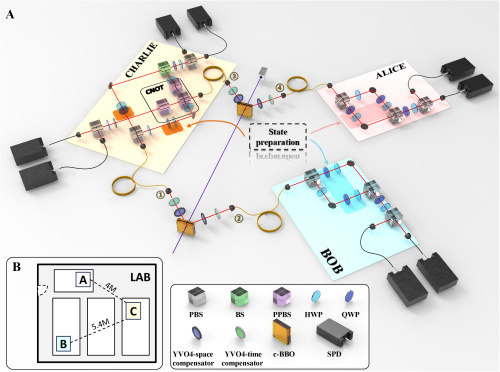Insider Brief
- Chinese researchers report they demonstrated an experimental quantum teleportation of a Toffoli gate, a multi-qubit operation, across three spatially separated parties within a photonic quantum network.
- The experiment involved encoding qubits into the polarization and path states of photons and achieved a fidelity of at least 0.706.
- The advance shows the feasibility of complex quantum gate teleportation and could significantly reduce the complexity of distributed quantum computing.
Chinese researchers demonstrated the teleportation of a Toffoli gate across three spatially separated parties in a photonic quantum network, a feat the researchers report is a significant step in the field of distributed quantum computing.
This experiment, described in a study in the journal Optics Express, reportedly marks the first time that a multiqubit quantum gate, such as the Toffoli gate, has been teleported between remote nodes, offering a glimpse into the potential of quantum teleportation for more complex quantum computing tasks.
As quantum communication and computing technologies evolve, the researchers write that the ability to perform remote operations will be critical for realizing the full potential of quantum computing and, while there is still more work to be done, this successful experiment paves the way for further research and new applications in quantum computing, communication and metrology.

The team writes: “These results show the feasibility of teleporting complex multi-qubit quantum gates and may provide an effective method for reducing the experimental complexity of distributed quantum computing, which relies on quantum state teleportation or solely on two-qubit distributed gates.”
The research team from Southern University of Science and Technology in Shenzhen, China, led by Xiduo Dong, Shiting Liu, and Ya-Li Mao, conducted their experiment by using photons as qubits, encoding their quantum information in the polarization degrees of freedom of the photons. They employed entangled photon pairs generated through spontaneous parametric down-conversion (SPDC) processes to establish quantum entanglement between the three network nodes. This entanglement provided the necessary resource for the teleportation of the Toffoli gate.
Quantum teleportation, originally demonstrated in the 1990s, has been primarily used to teleport individual quantum states between two parties. Extending this concept to the teleportation of multiqubit quantum gates represents a critical step forward for quantum networks and distributed quantum computing, where multiple quantum processors could work together to solve complex problems.
A Toffoli gate, also known as a controlled-controlled-NOT gate, is a quantum logic gate that manipulates three qubits. It flips the state of the third qubit only when the first two are both in the “1” state, making it essential for performing certain reversible computations and for constructing circuits that are vital to quantum error correction. It is also used in many quantum algorithms, including Shor’s algorithm for factoring large numbers and various quantum error correction protocols.
In their experimental setup, the researchers encoded three system qubits and one auxiliary qubit in the polarization states of photons, while three additional auxiliary qubits were encoded in the path degrees of freedom of the photons. This allowed the team to perform the teleportation of the Toffoli gate with high efficiency, according to the paper.
The experiment involved two sandwich-like combinations of β-barium borate crystals, a type of barium borate crystal that is commonly used in advanced optical technologies. A pulsed ultraviolet laser pumped the crystals to generate the necessary entangled photon pairs. These entangled pairs were distributed between the three network nodes, which the researchers labeled Alice, Bob and Charlie.
The teleportation was achieved by implementing a local controlled-NOT (CNOT) gate at the locations of Alice and Bob, with the Toffoli gate being applied using partially polarizing beam splitters (PPBS). After the quantum operations were completed, the state of the teleported Toffoli gate was measured, and the fidelity of the gate was calculated using the Hofmann method, a technique used to better understand the energy levels of particles or systems by refining guesses about how they behave. It works by adjusting and improving those guesses until they closely match the actual behavior of the system, helping scientists get more accurate results..
The fidelity of the teleported Toffoli gate in this experiment was found to be at least 0.706 ± 0.131.
In quantum computing, fidelity ranges from 0, which is completely inaccurate to 1, or perfectly accurate), so a fidelity of 0.706 means that the operation was about 70.6% accurate. The fidelity, then, is fairly good for quantum computing and, at the very least, demonstrates the feasibility of quantum gate teleportation in a distributed quantum network.
The team adds that their setup lends itself to teleporting other complex quantum states.
They write: “Note that, our experimental setup can be easily transformed to teleport a controlled-controlled-phase gate (CCZ) solely through the manipulation of two HWPs in the apparatus of local Toffoli gate at the location of Charlie.”
Implications For Quantum Computing and Quantum Communication
This experiment has several implications for the future of quantum computing and quantum communication. One of the key advantages of using photonic quantum networks is the ability to transmit quantum information over long distances without significant loss or decoherence, making them ideal for connecting quantum computers in different locations. The successful teleportation of the Toffoli gate suggests that more complex quantum operations can be performed across a network of quantum computers, paving the way for scalable distributed quantum computing.
In addition to its practical applications, the teleportation of the Toffoli gate has theoretical importance in the field of quantum information science. Multiqubit quantum gates, such as the Toffoli gate, are not strictly necessary for quantum computation, as they can be decomposed into sequences of one- and two-qubit gates. However, the direct implementation of multiqubit gates can offer advantages in terms of efficiency and fidelity, particularly in systems where quantum resources are limited or where minimizing the number of gate operations is critical.
The research team’s successful demonstration of the teleportation of a Toffoli gate could also have implications for quantum error correction and fault-tolerant quantum computing. Quantum error correction relies on the ability to detect and correct errors in quantum states without directly measuring the state itself. The Toffoli gate is a key component of many quantum error correction protocols, and the ability to teleport this gate across a quantum network could enable new methods for distributing error correction operations across multiple quantum processors.
The researchers involved in this study were affiliated with multiple institutions. In addition to Dong, Liu and Mao, the team included: Bixiang Guo, Shufeng Xu, Hu Chen, Yuxiang Guo, Zheng-Da Li, and Jingyun Fan, all associated with the Shenzhen Institute for Quantum Science and Engineering at the Southern University of Science and Technology in Shenzhen, China. The research was conducted in collaboration with the International Quantum Academy and the Center for Advanced Light Source, both also based in Shenzhen.


















